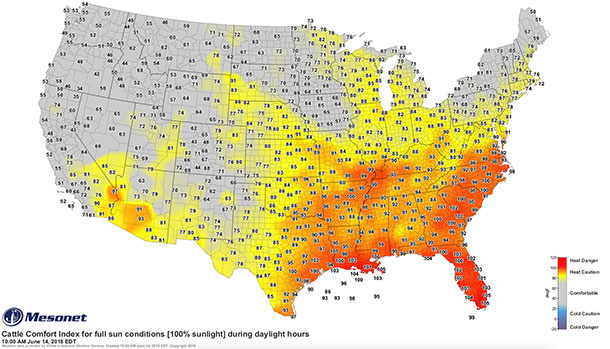Heat stress in cattle is a prevalent problem that has been around since the beginning of cattle production. Dr. Michael Baird of Avery, Texas, is a veterinarian specializing in large animals. In an area stricken by heat stress each and every summer, Baird is no stranger to the prevention and treatment of heat stress.
Baird describes heat stress as a condition caused by excessive heat in which the cattle experience an array of symptoms ranging from a decrease in comfort and performance to death.
Baird says repercussions of heat stress include a decrease in weight gain, feed consumption, milk consumption and conception. These negative effects can be prevented by supplying shade, water and fans to your herd and by minimizing handling and overcrowding.
Prevention of heat stress isn’t always as easily attainable as cattle producers need it to be. Installing more stock tanks or building shaded areas can become pricey, and if producers are experiencing high temperatures in the early summer months, it may be too late to take precautionary measures. When prevention is lacking, we move to treatment, and in order to treat cattle, producers must know the signs. Here are Baird’s sure signs to look for when determining if your herd is experiencing heat stress:
1. Rapid, labored, open-mouth breathing
According to the U.S. Meat Animal Research Center (MARC), the cattle’s breathing rate is the most prominent sign of heat stress. If you see a member of your herd breathing at a rapid rate, open-mouth breathing, drooling or foaming at the mouth, or breathing with their tongue overhanging their mouth, you should lead this animal to the shade immediately.
2. Excessive time spent in the shade
Although shade is one of the biggest keys to preventing heat stress, it can also be a sign that your cattle are experiencing heat stress. Cattle will spend more time in and around shady areas and stock tanks in an attempt to cool themselves down.
3. Recumbency
Recumbency in your herd can look like anything from lying down under a shade tree to walking with their head down. Resting is a natural and instinctual way cattle combat fatigue caused by heat stress.
4. Crowding
Experts point to different stages of how cattle congregate in their corrals as behavior patterns showing signs of heat stress. In early stressful stages, animals may be standing in the pen and growing restless or grouping together. But in the late stages of heat stress, as individual animals become more isolated from the herd, they should be observed for more intense signs.
More signs and stages can be learned at the USDA Agricultural Research Service website.
Producers may not feel their strategies are effective in such overwhelming periods of summer heat. But MARC scientists also suggest more steps for avoiding heat stress.
- Monitor the weather.
- Ensure there are no restrictions to air movement, such as hay storage or windbreaks, where cattle are housed or being worked.
- Check stock tanks to ensure adequate water. Make sure to have adequate access for multiple animals to drink at one time. Check reserves, pumps and all the parts of the watering system. Check the refill rate of the stock tanks.
- Consider additional water tanks if space and tank refill is not adequate. Remember, water intake decreases when water temperature is over 80ºF. Buried water lines are preferred so the water is cool when it reaches the tank.
- Remove manure buildup under man-made shade structures. Thick manure packs are a heat source; manure buildup should not exceed 1 inch in depth.
New tools for weather
Researchers have developed new online material to inform producers when they run the risk of working cattle in conditions that are too dangerous.
The collaborative project, funded by the USDA and supported by Kansas State University, Oklahoma State University and the University of Oklahoma, along with weather co-op Mesonet, has resulted in a National Cattle Comfort Index guide that maps conditions in all months of the year.
Click on the image below to view a larger image.
Maps developed focus on three stages:
- Cattle Comfort Index at 100 percent solar radiation
- Cattle Comfort Index at 60 percent solar radiation
- Cattle Comfort Index at 20 percent solar radiation
Additional criteria in the maps show air temperature at 1.5 meters, wind speed at 10 meters, percent relative humidity at 1.5 meters and solar radiation at the 100, 60 and 20 percent levels.
The 100 percent solar radiation map is recommended for determining the maximum stress level in summer months and the 20 percent solar radiation map is for winter months.
If producers see signs of cattle heat stress or can see weather patterns that threaten their herds, they should cease working their livestock and get them to cool down in shadier areas or where there is access to unrestricted air movement. ![]()
Mayzie Purviance is a freelancer living in College Station, Texas.
PHOTO: Screenshot courtesy of National Cattle Comfort Index guide.







